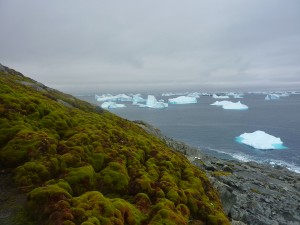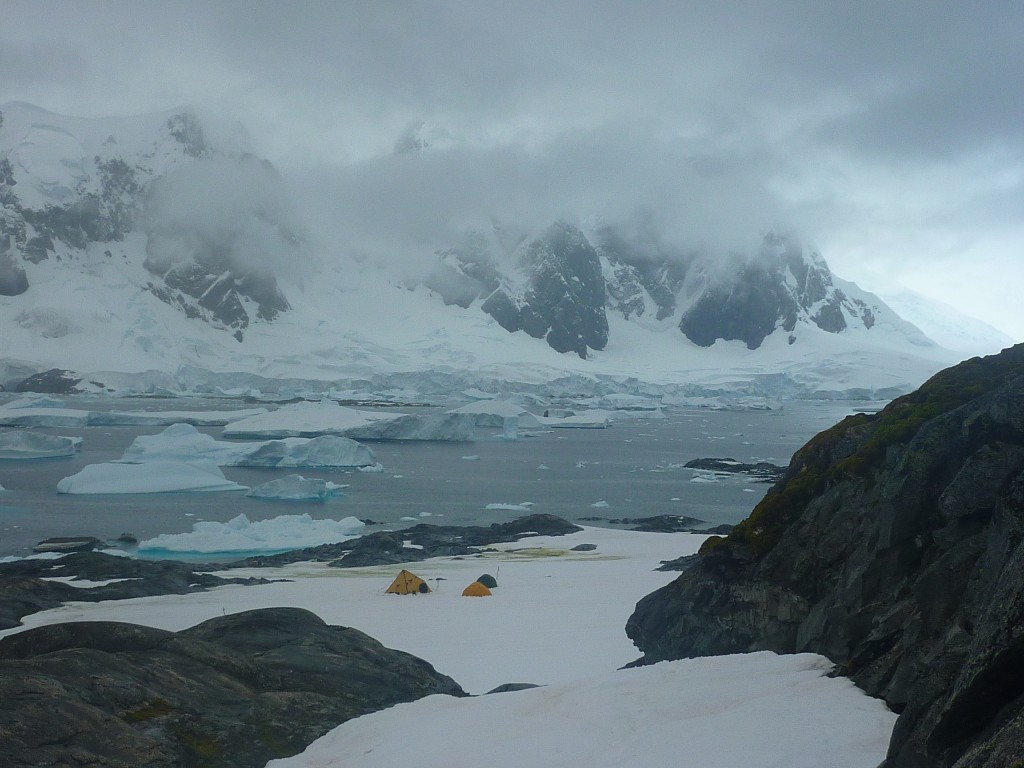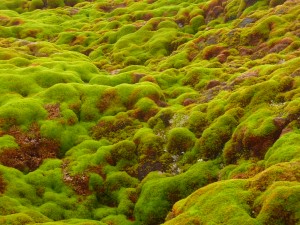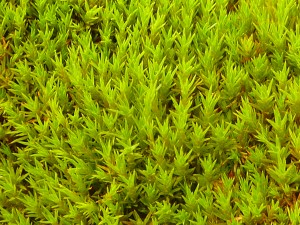This page was contributed by Matthew Amesbury from the University of Exeter. All photographs are copyright Matthew Amesbury.
Antarctic science – it’s NOT all about the ice! | A 4000 year record of Antarctic Peninsula climate change | Moss banks on Green Island | Moss banks as a palaeoenvironmental proxy | Further Reading | References | Comments |
Antarctic science – it’s NOT all about the ice!

Regular readers of the AntarcticGlaciers website could be forgiven for thinking that science in Antarctica is all about the ice. You might, for example, reasonably expect a research project studying Antarctica’s past climate to be using ice cores, some over 4 km thick and hundreds of thousands of years old.
But in the northernmost extremes of this undeniably icy continent, on the Antarctic Peninsula, a quite difference source of scientific information is slowly growing away, locking in information as it goes, minding its own business in the mere 0.3% of the Antarctic continent that is ice free. What is it?! Deep banks of moss have been accumulating on islands to the west of the peninsula for thousands of years and research is currently underway that exploits these remarkable formations as an archive for information on past climate change in the region.
Dramatic temperature changes over the last 50 years have resulted in changes in these moss banks, which were unprecedented over the last 150 years.
A 4000 year record of Antarctic Peninsula climate change
Antarctic Peninsula temperatures have risen by 3°C over the past 50 years, making it one of the most rapidly warming parts of the globe. This warming has been associated with a range of impacts including decreased sea-ice extent, ice-shelf collapse and glacier retreat. However, meteorological data has only been recorded on the Peninsula since the 1950s, so our knowledge of the longer term context of this temperature rise is limited. To address this, we are developing records of past climate stretching back some 4000 years from these slowly growing moss banks.
Moss banks on Green Island

As a temperate peatland scientist by training, I still have to pinch myself to think that just over a year ago to the day, I was on a ship crossing Drake’s Passage (the less detail I give you of that journey the better for everyone) bound for the most extraordinary fieldwork I’m ever likely to undertake. We were heading for Green Island, a small rocky bump and Antarctic Specially Protected Area not far from the Ukrainian Vernadsky/Faraday research base about half way along the western side of the Peninsula.
The year before (2012), my colleagues had attempted to take a core from the very same island but were held back by impenetrable pack ice. Last year, despite passing through uncharted waters, seas choked with heaving, grinding icebergs and a whipping cross current, we managed to make our landing along with 500 kilograms of field kit (including the pre-requisite months worth of emergency rations) on a rocky embayment on the sheltered eastern side of the island.

Moss banks as a palaeoenvironmental proxy
Mild summers allow slow moss growth

The days that followed perfectly illustrated why mosses have been able to take a hold and grow in this area. Temperatures hovered well above freezing (warmer than the UK at the time) and the rain lashed down as we worked away on the exposed banks. In the short Austral summer, it gets just about warm and wet enough to permit vegetative growth in this part of the Antarctic Peninsula. The Polytrichum mosses at the surface of the moss banks might have the time and energy to grow by just a few millimetres each year before being frozen solid and covered in snow over the winter. The following year they will wake up and start all over again. By such small increments have enormous moss banks grown – on Elephant Island, a site perhaps more famed for its role in Shackleton’s ill-fated Endurance expedition in 1916, the moss banks are almost three metres deep!
Past climate archives

The moss banks we study are ideal archives for research into past climate. The plant material in them is well preserved through freezing in permafrost, so it can be dated easily using radiocarbon dating. They are dominated by just one or two species making results simpler to interpret and despite the seemingly slow growth rates, low levels of decomposition mean we can develop records with about one sample per decade – pretty high resolution for this type of study.
Cores of moss show rapid and unprecedented change over the past 50 years

By taking cores through the banks of moss, we can reconstruct temperature and precipitation rates through the last few centuries, long before the instrumental record. So far, we’ve been able to show that rapid changes in a moss bank located at the southernmost extent of moss growth on the Peninsula were coincident with the rapid temperature changes recorded over the past 50 years and unprecedented over the past 150 years. We continue to work on extending this context back further in time from our deeper cores.
A welcome splash of green moss

So next time you think about all the science taking place in Antarctica, spare a thought for the tiny proportion of this remarkable continent covered in hardy mosses, providing a welcome splash of green on an otherwise white canvas.
Further reading
- Visit the project website here to find out more.
- Visit the Bogology website to find out more about peat and bogs and moss and climate change.
- Unlocking the Secrets of Antarctic Moss Banks (Planet Earth)
About the Author

Matt Amesbury is a Research Fellow at the University of Exeter. He is an expert testate amoebae analyst with broad interests in Holocene climate change and peatland palaeoecology. He is currently working on peat from New Zealand as well as moss banks in Antarctica. He is co-founder of the website Bogology which aims to share the science of peatlands and past climate change in a light-hearted and accessible way. He’d love you to visit him there.

What is the colonizing species, is it the moss or does lichen precede it?
Hi Mauri,
Thanks a lot for your interest and question. This reply is written along with Jessica Royles of BAS and the University of Cambridge, who also works on the moss banks project. She’s written more about Antarctic mosses here: http://bogology.org/2013/10/16/how-do-mosses-survive-in-antarctica/.
Essentially, the answer to your question is that the mosses are the colonisers and are not preceded by lichens. An entirely new and separate moss bank starts to grow when flat or gently sloping ice free ground is colonised by a moss fragment that has either blown from another bank, or been dropped by a bird – it is largely too cold for the mosses to produce flowering structures and spores. There are two moss species that tend to colonise the bare ground: Sanionia uncinata and Warnstorfia sarmentosa. After the initial colonisation, which generates a layer of mossy organic matter above the ground, the conditions may be suitable for the two moss species that form the deep moss banks to start growing. The moss Chorisodontium aciphyllum dominates moss banks on the wetter, more northern islands, whilst Polytrichum strictum is the major species in the drier, more southerly parts of the Antarctic Peninsula. With low temperatures and high winds the whole colonisation process is very slow and probably successful on only a very few occasions. Most of the expansion of the moss banks will be sideways spread of banks that are already established.
Thanks for the detailed answer. One more it makes sense utilizing the mosses as a temperature proxy, however, I am curious as to how they are used as a precipitation proxy.?
Hi Mauri,
Admittedly, saying that the use of the moss bank proxies can tell us directly about either temperature or precipitation is a simplification in the telling of the story in a blog! You might be interested to have a read of the paper we recently published in Current Biology from a moss bank at the southernmost limit of their growth at Lazarev Bay – there’s a link above (in particular the section entitled Biological Responses to Climate Change). In this paper we hypothesise that due to the consistent and clear changes in the moss bank proxies that coincide with recorded temperature rises (driving an increase in growing season length), that temperature is the primary driver. However, it’s also clear that moisture availability will have an effect on the moss banks. For example, the same 50 year period that saw rapid temperature increases also saw an increase in precipitation events and precipitation falling as rain, which would increase free water availability to the mosses and also enhance growth and microbial activity. The carbon stable isotope record, for example, gives an indication of wetness as it is affected by surface moisture and is interpreted as a record of photosynthetic conditions, incorporating the response to both temperature and precipitation (I include another reference below for this work if you are interested to learn more).
So essentially, whilst temperature seems to be a primary driver, precipitation doubtless also plays a part. Hopefully by developing records from more sites (as we are now) as well as a detailed study of the surface samples and climate data we have collected on fieldwork, we will be able to understand in more detail exactly how the two interplay.
Royles, J., J. Ogée, L. Wingate, D. A. Hodgson, P. Convey and H. Griffiths. 2012. Carbon isotope evidence for recent climate-related enhancement of CO2 assimilation and peat accumulation rates in Antarctica. Global Change Biology 18, 3112-3124.
What other organisms are you finding with the moss?